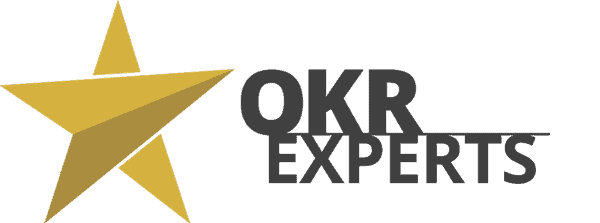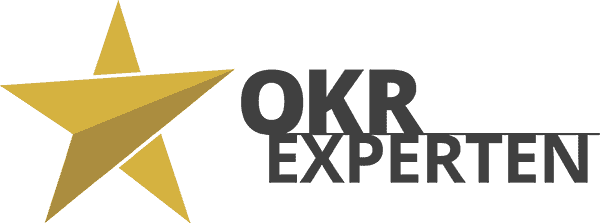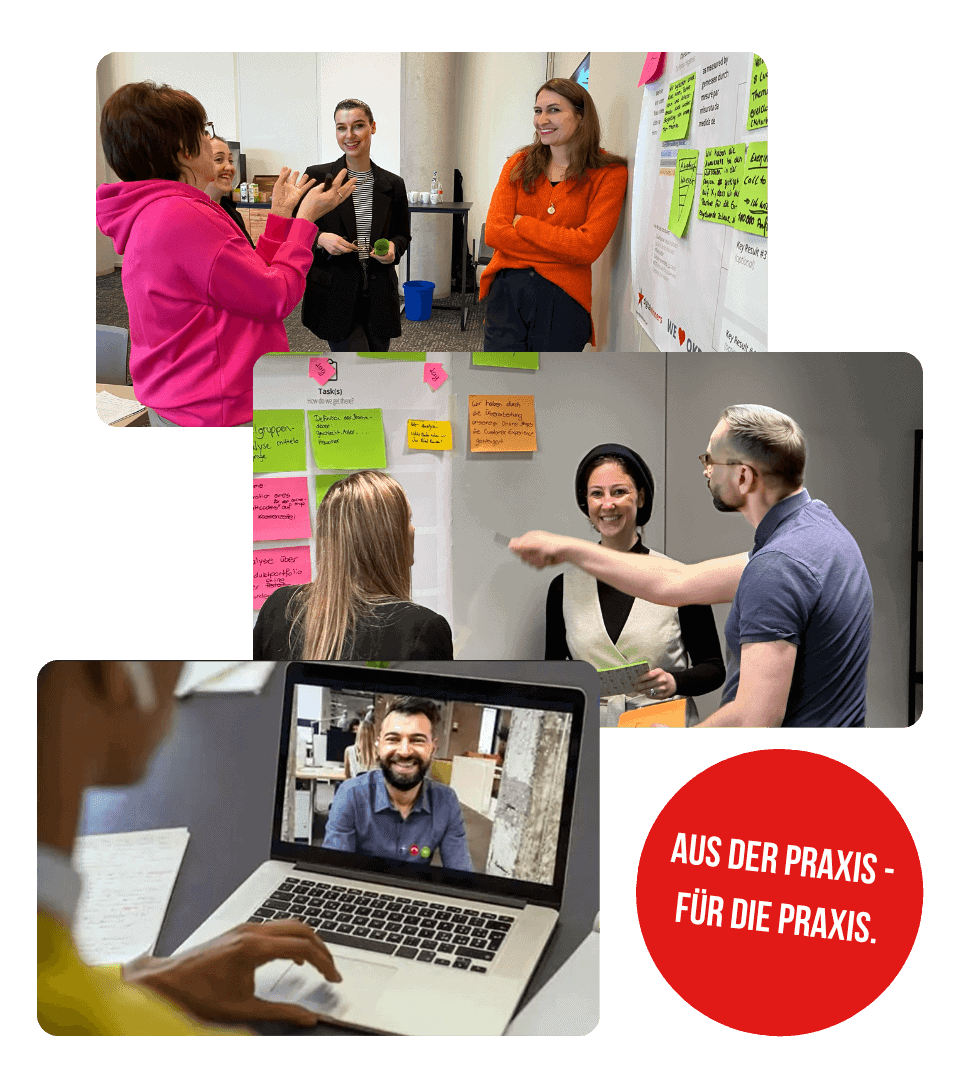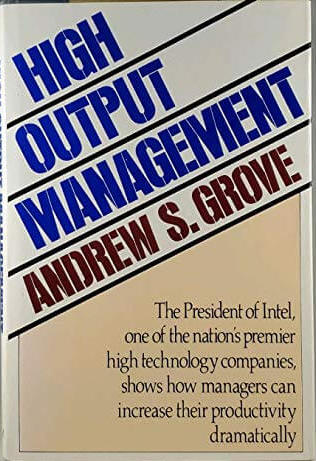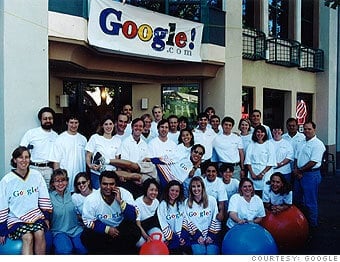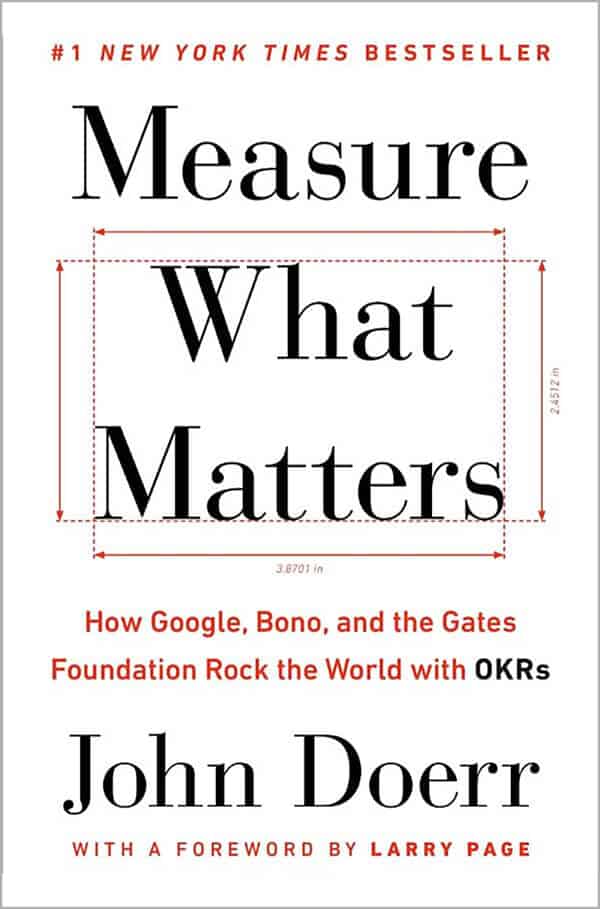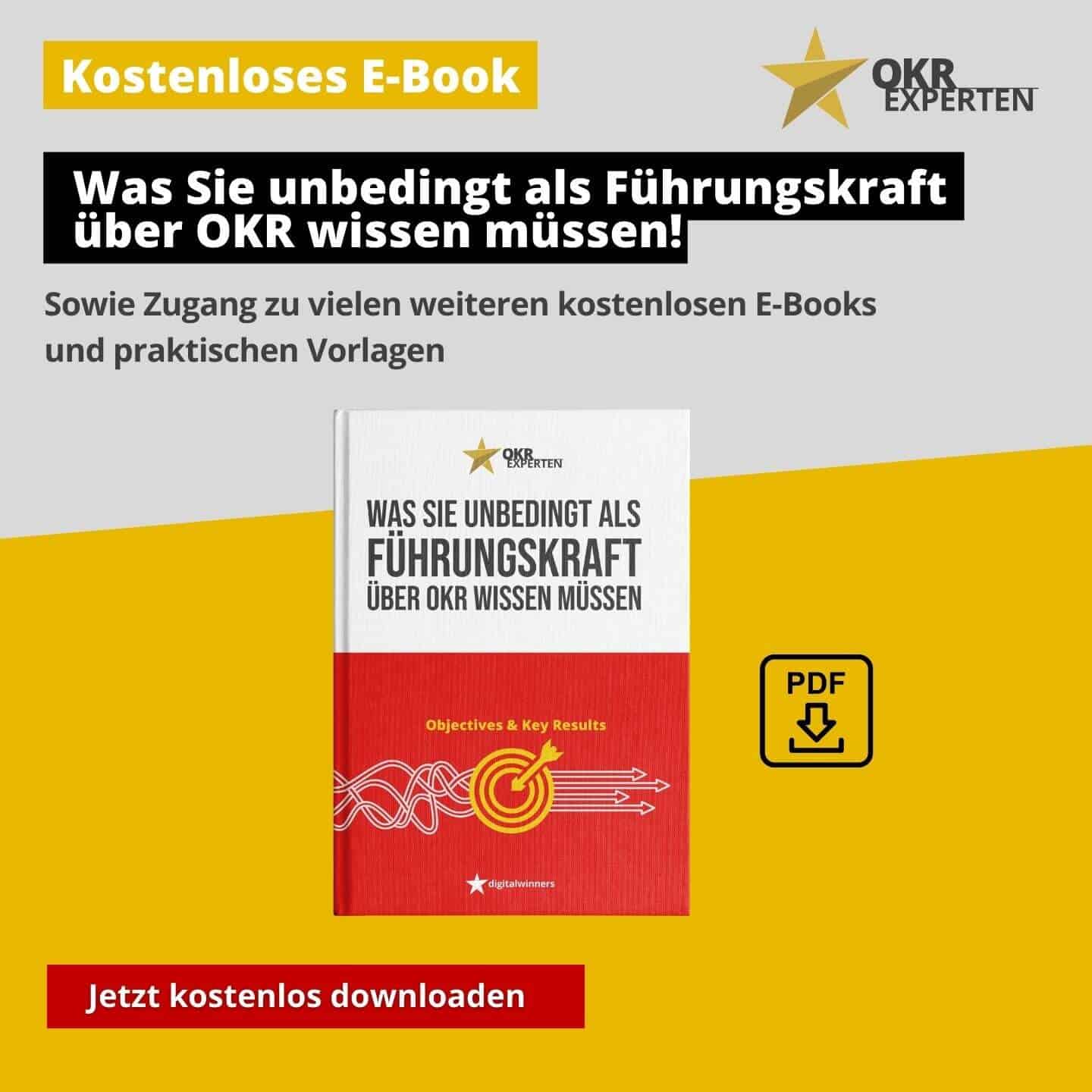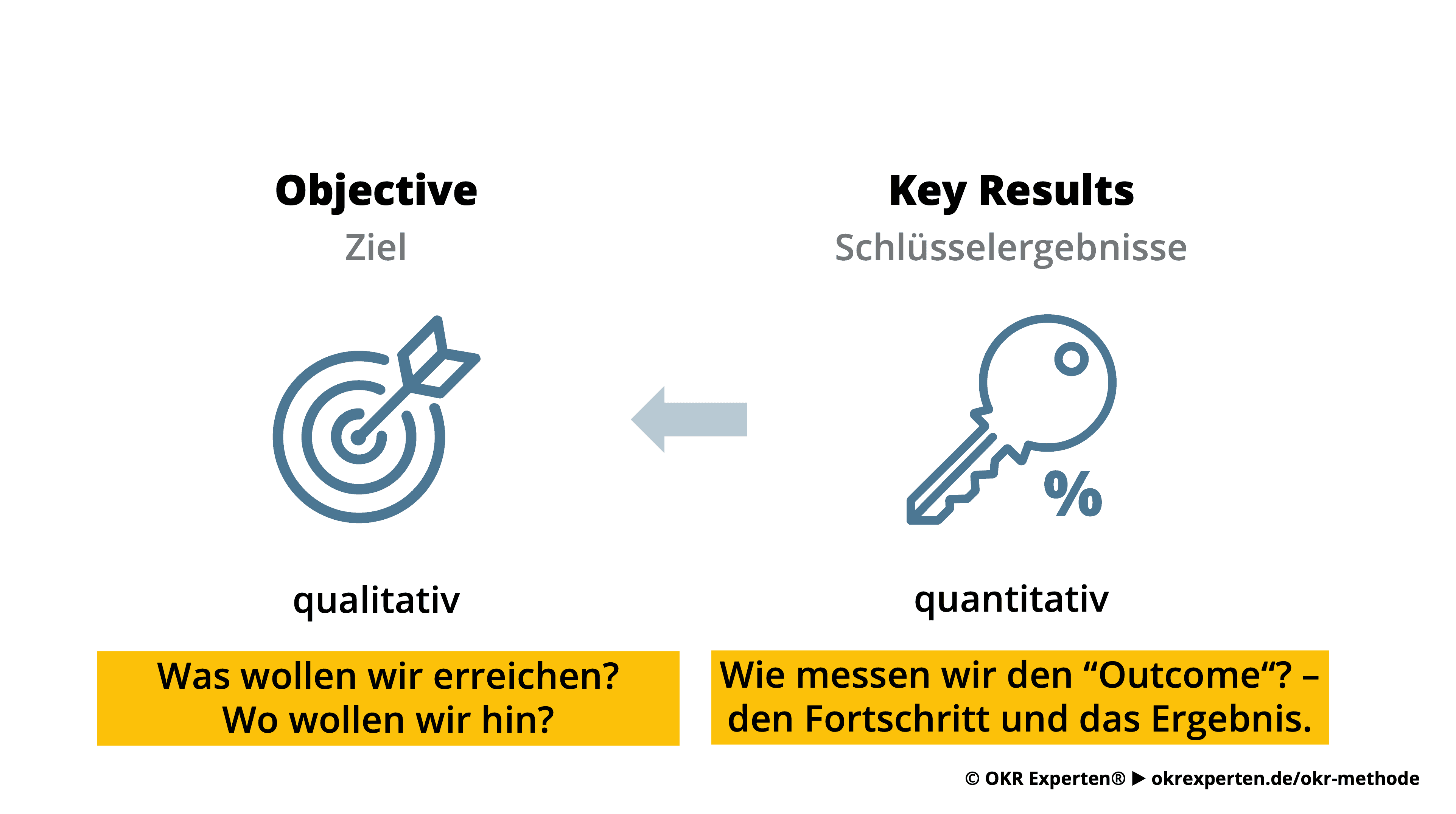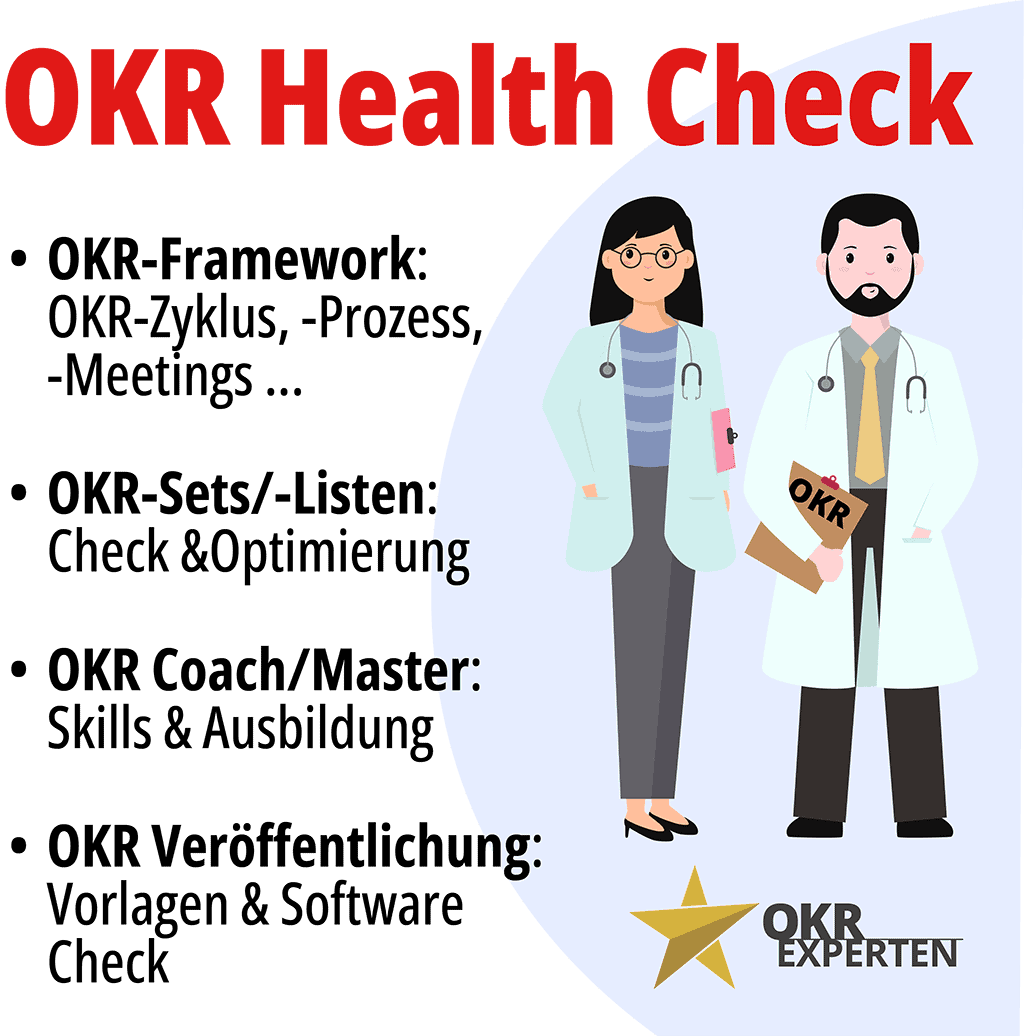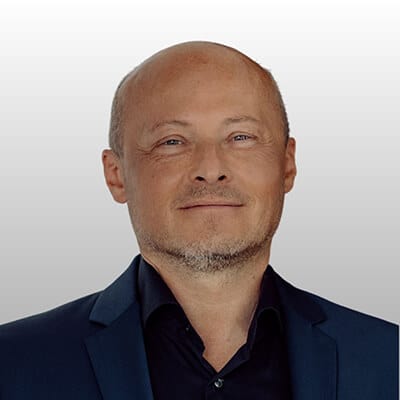The OKR Method – Introduction to Objectives and Key Results
The OKR method is a modern and agile framework for organizations and teams of all sizes that supports them in working together effectively and efficiently to implement their vision, strategy and planning – as well as their corporate goals.
It makes it possible to realize a vision through focus, clarity and transparency as well as motivation, passion and ambition.
In this article, we will introduce you to the basics of OKR: the OKR definition and the OKR framework – as well as some OKR examples.
Further OKR examples of good OKRs can be found on the OKR examples page – further reading on the OKR books page.
If you need support with the introduction of OKR – further information can be found on the OKR introduction page.
OKR introduction
We, the OKR experts, will be happy to support you with the introduction of OKR:
- Field-tested implementation process
- Avoid mistakes, reduce effort
- Top rated seminars & workshops
- Support with OKR tool selection
What is OKR?
OKR is an acronym that stands for “Objectives and Key Results”. It is a framework for setting objectives and measuring key results, as well as a critical approach to continuous improvement – in fact, an entire philosophy (which is why our seminars are not just about understanding, but about experiencing and internalizing). OKR promotes intrinsic motivation.
The question is best answered by applying OKR. The method is:
- a target setting method or target management method, as well as a target management system,
- an agile strategy implementation method and thus a strategy execution tool,
- a modern management method and leadership method for targeted and modern employee management
also ideal for distance leadership and servant leadership, - an agile operating system for the entire company.
Introduction to the OKR method – with goals to success
Agility versus continuity
OKR combines long-term and medium-term goals (vision, mission statement, corporate strategy) with short-term goals and tasks. OKR is an agile method and allows agility while at the same time ensuring a certain degree of continuity.
Agile strategy implementation – implementing the strategy in VUCA times
OKR is a system of continuous learning – from successes and failures/mistakes. It is a system that allows self-observation and thus promotes further development and evolution. OKR is a method for “learning strategy development” in which smaller measures are started before the evaluation of various alternatives has taken place – a slow, tentative approach to the strategy process.
Combination with other agile methods
The OKR method can be introduced well in agile organizations that are already working with other frameworks, such as
Scrum
and
Kanban
– as well as with scaled Scrum frameworks such as SAFe®, LeSS and Nexus. Also the approaches of the Lean Startup Model: e.g. the Build-Measure-Learn cycle, the MVP approach and much more. can be easily combined and supplemented with OKR. Here is an article on how OKR can complement SAFe and SAFe OKR.
OKR in the various organizational forms
OKR also works in any organizational form for the implementation of corporate goals: Line and matrix organization, squads/chapters/tribes (Spotify model), holocracy or holacracy as well as sociocracy.
OKR as a management method
OKR can also be seen as a modern management method: for the management of individual teams by a manager in the sense of “servant leadership” – as well as individual employees if necessary, although we do not recommend the latter, as the team spirit can quickly be lost. OKR allows a high reaction speed to new situations and thus increases the resilience of companies.
Conclusion – OKR is much more than setting and pursuing goals
This makes the OKR method an effective tool that is gaining in importance and popularity, especially in these times of rapid change and increasingly distributed teams in home offices.
OKR Full Service Agentur
Wir, die OKR-Experten, unterstützen Sie gerne bei der OKR-Einführung & Optimierung:
- Beratung & Begleitung
- Seminare & Workshops
- OKR-Software Auswahl
Five reasons to use the OKR method – Why is the OKR model so successful? Advantages and principles of the OKR method
The acronym FACTS is a very good way of expressing the essence of OKR: FACTS stands for Focus, Alignment, Commitment, Transparency and Stretching.
Focus:
The method helps to bring a high level of focus to the company so that important goals are achieved. With OKR, focus on the right and important things is implemented effectively and efficiently.
Alignment (alignment):
The consistent alignment of all departments, teams, managers and employees helps to create an enormous willingness to cooperate and provide support.
Commitment (obligation/commitment):
A symbiotic interplay of top-down, bottom-up and horizontal target agreements creates an extraordinary level of commitment at all levels.
Transparency: Transparency:
Every employee and all managers know at all times what goals, success drivers and tasks their colleagues are working on in the company – this promotes and guarantees unprecedented transparency.
Stretching / Stretch Goals (challenging goals):
Stretch goals are challenging or ambitious targets. When applied correctly, the 10x method creates an enormous wave of motivation throughout the entire organization. The “stretching” of goals by formulating them in an extremely ambitious and sometimes even unattainable way (moonshot goals) leads to completely new, creative ways and ways of thinking that allow every company to scale extremely and thus make it even more successful. In this sense, “stretch goals” are achievable targets – using completely new creative approaches. Creativity and innovation techniques are also used to think much more strongly about the future. Find out more here.
OKR history – Where does the OKR method come from?
The method originated at Intel.
OKR at Intel – Intel MbO – iMbO
The founder of OKR is Andrew Stephen Grove – in short
Andy Grove
. He was a co-founder (“late founder”) and CEO of Intel for many years.
Intel, known for its PC microprocessors and the slogan “Intel inside”, was founded in 1968 by Gordon E. Moore (known for Moore’s Law) and Robert Noyce. Soon afterwards, Andy Grove, who managed the company in the 1980s and 1990s, was also hired. He was not a real co-founder, but had the status of a founder, hence “late founder”.
Grove introduced his “OKR” approach at Intel in 1971 – he was 35 years old at the time. In 1983, the approach was documented for the first time in his book “High Output Management“. In it, he presents the method of qualitative indicators (later “Objectives“) and measurable indicators (later “Key Results“) as part of a “Breakfast Factory”. At the time, Grove called his method “iMbO – Intel Management by Objectives” – as the name suggests, it was a further development of MbO – Management by Objectives.
At first glance, OKR appears to have some similarities with the MbO method, but differs in key aspects.
Book cover from 1983 – Copyright Random House Verlag
Advertisement: Order book (updated edition from 1995) at Amazon (commission link)

By loading the video, you agree to YouTube's privacy policy.
Learn more
Original video of a lecture by Andy Grove from the 70s
The OKR history at a glance – the history of goal management methods
The OKR history
OKR and John Doerr – employee of Andy Grove, then Investment Manager
1974 came John Doerr joined Intel at the age of 23. He worked as a sales representative at the time and attended a Grove “OKR course” in the 1970s, probably 1975.
Doerr moved to the Silicon Valley-based venture capital firm Kleiner Perkins (then Kleiner Perkins Caufield & Byer) in 1980, where he became an investment manager.
In 1999, Kleiner Perkins invested in Google – with Doerr as investment manager.
John Doerr – approx. in 1999
Source: Book The Google Story (2018 Updated Edition): Inside the Hottest Business, Media, and Technology Success of Our Time (English Edition) Kindle edition by David A. Vise and Mark Malseed
OKR Trainings & Schulungen
Wir, die OKR-Experten, schulen Sie gerne mit unseren modernen Training-Formaten:
- Seminare in Präsenz & Remote
- Offene Schulungen & Inhouse-Seminare
- Workshops & Video-Kurse
OKR on Google
In the same year, 1999, John Doerr introduced the topic of OKR at Google. At the time, Google employed just 40 people.
The new management approach was introduced and further developed over the years – and is still a key driver of Google and Alphabet’s success today.
A separate article about: OKR on Google
Read more about how OKR made Google successful.
Larry Page, the co-founder and long-time CEO of Google, later Alphabet, makes the following comments in Doerr’s OKR book “OKR: Objectives and Key Results: How to develop, measure and implement goals that really matter”:
OKRs have helped us to grow tenfold - time and time again.
Larry Page, co-founder and long-standing CEO of Google, later Alphabet
John Doerr publishes his book on the OKR method
In September 2017, John Doerr published his book on the OKR method entitled “Measure What Matters: OKRs: The Simple Idea that Drives 10x Growth”, which has been translated into numerous languages. The German title is: “OKR: Objectives & Key Results: Wie Sie Ziele, auf die es wirklich ankommt, entwickeln, messen und umsetzen”. His website: www.whatmatters.com
Other success stories besides Intel and Google
Other OKR success stories include: LinkedIn, Twitter, Uber, Spotify and many more companies.
Als OKR Full-Service Agentur unterstützen Sie bei der OKR-Einführung und Optimierung – mit Beratung & Begleitung, OKR Seminaren & Workshops und bei der OKR-Software Auswahl.
Erno Marius Obogeanu-Hempel und unsere weiteren OKR-ExpertInnen
OKR-Einführung
OKR-Optimierung – Health Check
OKR-Training & OKR-Seminare
OKR-Workshops
OKR-Experten
OKR-Bücher
OKR-Vorträge
Zur Übersicht aller OKR-Angebote
Zur OKR-Experten Homepage
Oder rufen Sie uns an: +49 89 21 52 95 2 – 99
+43 720 02 21 68
+41 71 58 80 36 4
Als OKR Full-Service Agentur unterstützen Sie bei der OKR-Einführung und Optimierung – mit Beratung & Begleitung, OKR Seminaren & Workshops und bei der OKR-Software Auswahl.
Erno Marius Obogeanu-Hempel und unsere weiteren OKR-ExpertInnen
OKR is a “best of” various methods
As the OKR method combines the strengths and advantages of various goal-setting and management methods, OKR can be described as a “best-of” and a symbiotic further development of these:
Management by Objectives
(MbO) by Peter Drucker (1954): focuses on objectives and the achievement of objectives.- SMART by George Doran (1981): provides criteria for clearly defining goals – specific, measurable, achievable, relevant and time-bound.
Balanced Scorecard
(BSC) by Kaplan and Norton (1992): focuses on strategic measures.- Hoshin Kanri (mid-1960s): involves employees in the strategic alignment process.
The OKR format – What is an OKR set – the difference to other target setting methods
As the name suggests, OKR consists of objectives and key results– this is how the objectives are formulated:
The objective – What is an objective?
An objective is an inspiring, qualitative and ambitious goal. It describes what needs to be achieved. Objectives provide direction and describe the next stage in implementing or achieving the vision.
They therefore answer the question“What do we want to achieve?” or“Where do we want to go?“.
Objectives are…
- Qualitative – in the sense that they do not contain numbers.
- Directional – this means that they are aligned with the mission statement, strategy and annual planning.
- Result-oriented – in the sense that the objective describes the “outcome”, the benefit, the effect or the value contribution, not the output (e.g. projects, products, services, functionalities or documentation). It is not about the mindless processing of tasks, assignments or projects. OKR helps to coordinate and align daily work with the objectives on the basis of measurable impact. Outcome awakens the intrinsic motivation of employees.
- Ambitious – in the sense that the team is ambitious, the objectives motivate the team and challenge it at the same time.
- Inspiring and memorable – in the sense that they are short and
are concise – simple, but not boring. It is important that the objectives are understandable and easy to remember for everyone. They describe a goal that creates a concrete image in the mind and that can be visualized. - Scheduled – this means that the objectives are completed by the end of the OKR cycle at the latest. Implementable by the team – means that a team can implement them as autonomously as possible without outside help.
In our experience, two to a maximum of four objectives should be defined at one level, e.g. company, department or team. As a rule, fewer OKR sets are created for improvement topics for departments and teams that are mostly operationally active, while more OKR sets – up to four – are created for departments and teams that are more strategically active.
Examples of optimal objectives
Objective #1
We have gained valuable new insights from an extensive customer survey.
Objective #2
We have implemented measures to optimize customer interaction.
Objective #3
Thanks to the new optimized onboarding process, we have enthusiastic new employees right from the start.
Objective #4
We are heroes at turning sales contacts into hot leads that become enthusiastic customers.
Objective #5
We have a fully automated. Test environment with extensive unit tests set up for smooth continuous deployment.
Objective #6
We have a huge influx of new customers thanks to an ingenious new pricing strategy.
The key result – What is a key result? The crucial importance of key results in the OKR method
In contrast to an objective, a key result (sometimes abbreviated to “KR”) is a quantitative key result – clearly indicating whether an objective (outcome) has been achieved. It describes how we measure the outcome of our objective. Key results thus concretize the objective in the sense of the value proposition and measure progress towards the goal (objective).
This makes the objective measurable and answers the question“How do we measure the outcome?” – progress during the OKR cycle and the result after completion of the OKR cycle.
A key result increases the probability that the objective will be achieved – but it cannot be used to measure whether we were ultimately successful or not. For this purpose, the outcome and thus also the objective must be assessed.
Key results are …
- Quantitative and measurable results means that each key result must contain a metric and a number. However, it is not an annual KPI (Key Performance Indicator) or a KPI for operational topics. If possible, the metric should be a lead metric and not a lag metric.
- Outcome-driven in the sense that the key results measure the outcome, the benefit or the value contribution. They are not a list of tasks, work results or projects (“output”).
- Ambitious – in the sense that the team is ambitious, the key results motivate the team and challenge it at the same time.
- Timed – Key results must be formulated in such a way that they deliver results during or at the latest by the end of the OKR cycle. If necessary, results must be broken down into small parts in order to make a value contribution as quickly as possible within the OKR cycle.
- Implementable by the team – means that a team can implement the key results without external help, i.e. autonomously. This only applies at team level and usually requires cross-functional teams.
OKR Seminar mit offizieller Zertifizierung zum OKR Coach / Master
Wir, die OKR-Experten, bilden Sie gerne zum OKR Coach / Master aus:
- in Präsenz & Remote
- Erlernen & Erleben der OKR-Methode
- Best Practices, Tipps & Tricks
Examples of optimal KRs – Key Results
Key Result #1
Improvement in the Net Promoter Score (NPS) from -20 to 30
Key Result #2
Increase in the micro conversion rate of the order process (from shopping cart) from 30% to over 90%
Key Result #3
We increased the customer rating from 1.5 stars to 4 stars using A/B tests in the ordering process.
Key Result #4
We conducted interviews with influencers in competitive sports who posted stories on their Instagram channels with a total reach of 1 million followers have posted.
The OKR formula – the question of formulation
The following formulation by John Doerr can be used to formulate qualitative objectives and the corresponding quantitative key results:
The original formula reads: I will (Objective) as measured by (Key Results).
The exciting thing here is “measured by”: because only measurability makes a goal a real goal. If a goal cannot be measured, it is nothing more than a wish.
OKR Videokurse
Wir, die OKR-Experten, schulen Sie gerne mit unseren beliebten Video-Trainings:
- OKR schnell und einfach lernen
- Überall lernen mit Laptop, Smartphone oder Tablet – im Büro, zu Hause oder Unterwegs.
- Quizzfragen & Teilnahmezertifikat
- Zertifizierung zum OKR Coach / Master (separate Prüfungsgebühr)
Interaction of an objective and several key results – What is an OKR set?
The OKR method uses so-called OKR sets. An OKR set consists of an objective and several key results:
One objective and two to four key results form an OKR set. The most relevant success drivers are selected as key results, i.e. the results with the greatest effect on target achievement. The relationship between objectives and key results is similar to that between atomic nuclei and electrons – they cannot exist without each other.
That’s what makes a good OKR set…
- independent key results, i.e. they do not influence each other and do not build on each other or depend on each other over time.
- Key Results, which break down the results as far as possible into their logical dimensions according to the MECE method (“mutually exclusive and collectively exhaustive”), i.e. without overlapping and completely.
- per objective two to max. Four key results. Too few key results do not fully describe the objective in its logical dimensions. If there are too many key results, you lose the overview and there are often overlaps.
Tasks, tasks, activities
The activities that lead to progress towards the fulfillment of objectives, in particular key results, are tasks or projects.
In practice, it quickly happens that key results are a list of tasks, i.e. they describe the output and not the outcome. To get closer to the “outcome”, ask yourself why you want to work on a particular task, what purpose you are pursuing with it, what problem you are solving with it.
Where does that come from? Traditional target and performance systems are designed to reward activities. This means that employees are incentivized for the completion or processing of tasks – the more that is done, the better.
Far too little or no attention is paid to the benefits. OKR sets – Objectives as well as Key Results, however, focus on the outcome, the benefit, the effect.
MOALs – Mid-term gOALs – medium-term objectives and milestones
In principle, the OKR method can also be used for annual OKRs. MOALs are mid-term gOALs, usually annual targets in the form of OKR sets or formulated as a target (“Goal”) and supplemented with target KPIs. These targets for an entire year are then broken down into quarterly targets.
OKR examples
Here is an example of a good OKR set:
We are happy to formulate examples based on a sample company and situation. Our sample company produces caps and jerseys for clubs and associations.
The situation: The sample company currently has low customer satisfaction and would like to address the issue and create a data-driven basis for possible measures.
Objective #1
We have gained a clear understanding of which satisfaction drivers are relevant for customers in our interactions with them
Key Result #1
We analyzed 500 responses to an extraordinary online customer survey to develop measures
Key Result #2
We validated our hypotheses for the development of measures by conducting 15 qualitative personal interviews with our top-selling customers who had bailed out
OKR examples for different departments – one OKR example per department with good metrics / metrics
Further examples in the article OKR examples – qualitative objectives and quantitative key results.
OKR Software or OKR Tool
OKR software or an OKR tool can support the creation, coordination, publication, communication, measurement, tracking and visualization of objectives and key results.
Why should you use OKR?
As with any tool, the OKR method also depends on the correct application, because “A fool with a tool is still a fool“. The right environment, the “milieu”, is also important: management style, practiced corporate culture and much more.
Used correctly, OKR helps to implement the company’s vision in iterative cycles:
- Plan & Align: OKR helps to plan the implementation of the vision and strategy and to coordinate the measures at all levels and with all departments and teams.
- Execute & Progress: OKR supports the execution of measures through a clear focus. Progress is measured, assessed and discussed.
- Inspect & Adapt: All teams review progress based on data and learn from success and mistakes.
The OKR cycle
The OKR cycle is divided into three phases: Planning phase, execution phase and completion phase.
The OKR cycle is iterated over and over again. The duration of a cycle, the so-called cadence, can range from two to 6 months – most companies work with a cadence of 3 months.
The main person responsible for implementing the OKR process and OKR coaching is the OKR Coach, OKR Master, OKR Shepherd, OKR Facilitator, OKR Champion … – So far, no standardized term for the role has been established – in contrast to the Scrum Master in Scrum, for example.
Here is a brief overview of the OKR cycle:
The OKR cycle
The planning phase – setting objectives for the entire company
The OKR cycle begins with the planning phase. As part of this, the OKR sets are created at the beginning of the OKR cycle in so-called OKR planning(definition of OKRs), initially at the organizational level or company level (top-level OKR sets) with the mostly strategic objectives. Then the departments create their OKR sets based on the top-level OKR sets and then, based on the department OKR sets, the teams, if possible in self-organization. In some cases, OKR Planning is divided into OKR Drafting and OKR Refinement.
Tuning: top-down, buttom-up and horizontal
Vertical coordination from company level via departments to the teams is called top-down coordination. In addition, teams can propose ideas for OKR sets to the departments and the management or leadership team. This allows teams or departments to create individual / local targets in parallel to the top-down process and negotiate them with the next higher level. This voting is called bottom-up voting.
Parallel to this, horizontal coordination takes place between the departments and teams.
The execution phase – now the work really begins
During the execution phase of the OKR cycle, work is carried out on the actual target fulfillment and progress is measured and monitored. OKR events – both daily and weekly check-in meetings – are held for this purpose. The daily stand-up meetings are called Daily Huddles. The weekly meetings are called OKR Check-in or OKR-Weekly.
If completely unexpected, very drastic events such as a pandemic lockdown, 9/11, … occur, extraordinary OKR planning can also take place during the execution phase and new OKR sets can be created.
The final phase – we measure the result and learn from success and mistakes
At the end of the OKR cycle (usually at the end of the quarter), the OKR sets are measured in the OKR Review in all teams in the final phase and the achievement of the target (the objectives and key results) is assessed. In addition, at the end of the cycle, the OKR process and collaboration are assessed in an OKR retrospective in all teams, thereby optimizing the method and collaboration. The content-related and methodological findings are incorporated into the next cycle. The relatively short cycles of typically 3 months create a relatively high level of agility throughout the company.
The OKR meetings at a glance
Here is an overview of the OKR meetings. Certain meetings may already be established, such as the Daily Standup or Daily Scrum or a weekly status meeting or one-on-one meeting – the agenda is then changed or supplemented in terms of OKR.
Conserve resources – combine meetings
It can also make sense to combine them with other meetings, such as the OKR Weekly with a Scrum sprint review. The duration given is a guide value, but may vary from company to company, depending on the company level and number of participants.
(Table can be scrolled horizontally on smartphones)
| Meeting | Beschreibung | Frequenz | Dauer |
|---|---|---|---|
| OKR Planning | Erstellung der OKR-Sets auf allen Ebenen | am Anfang jedes OKR-Zyklus, typ. jedes Quartal | 4 Stunden bis 1 Tag |
| Daily Huddle | tägliches Check-In Meeting – vgl. Daily Scrum | jeden Arbeitstag | max. 15 Minuten |
| OKR Weekly | wöchentliches Check-In und Status-Meeting | jede Woche | 30 – 60 Minuten |
| OKR Review | Präsentation der OKR-Sets mit Status- und Auswertung (Score) | am Ende jedes OKR-Zyklus, typ. jedes Quartal | max. 90 Minuten |
| OKR Retrospektive | Verbesserungspotentialen zur Umsetzung im anstehenden OKR-Zyklus | am Ende jedes OKR-Zyklus, typ. jedes Quartal | max. 120 Minuten |
The degree of target achievement
With a key result, a simple yes or no assessment is possible: Was the goal achieved or not?
What if the target was only just missed or 80% achieved? Although the target was not achieved, progress was made. This means that a certain degree of success has been achieved.
In order to do justice to this fact, the results are evaluated on the basis of the degree of target achievement (or “score”) on a percentage scale ranging from 0 to 100 percent or from 0 to 1.0.
The OKR traffic light
The degree of achievement or score is divided into three areas and assigned to the traffic light colors red, yellow and green. This is why it is also referred to as the OKR traffic light:
- Green stands for the achievement of a key result according to the motto “We have delivered” – between 0.7 and 1.0. From 0.7, the target is considered achieved. John Doerr’s famous quote applies here: “70 percent is the new 100 percent.”
- Yellow stands for partial achievement according to the motto “We made progress, but couldn’t quite make it” – between 0.4 and 0.69.
- Red stands for non-achievement according to the motto “We have not managed to make real progress” – between 0 and 0.39.
Failure is an option
In traditional target systems, we are used to having to achieve or even exceed 100 percent. In the OKR methodology, it is perfectly fine to achieve 70 percent or 0.7.
It is important that the company has a healthy error culture and that it is accepted that a goal can be missed. Because the goals are very ambitious. This also applies to the micro conversion rate of over 90 percent in our example.
Confidence level
The score can also be viewed according to the traffic light system in the weekly OKR status meetings. At the beginning of an OKR cycle, however, the traffic light always shows red, as no progress or no major progress has been made. For this reason, it is much more important in this phase to monitor the assessment or the so-called confidence level.
This indicates the probability, i.e. the confidence, of achieving a result of 0.7 or better at the end of the OKR cycle (or at any earlier point in time defined in the key result).
As this is a purely subjective assessment, the confidence level values defined as percentages are assigned corresponding descriptions in practice, for example:
- 0 percent: not started – not yet started.
- 10 percent: in trouble – in difficulties. This key result is in so much trouble that we will never reach the score of 0.7.
- 30 percent: at risk – endangered. This Key Result is in trouble and we will probably not reach the score of 0.7.
- 50 percent: off track. Although we have lost our way somewhat, we are confident that we will achieve the key result with a score of 0.7.
- 90 percent: on track – on course. We are confident that we will achieve the key result with a score of 0.7.
- 100 percent: completed – done!
KPIs – Key Performance Indicators
In parallel to the OKR method, the teams can use KPIs to measure and monitor their operational performance. Operational targets can also be defined with KPIs – targets for a cycle, up to the end of the year or even for long-term corporate goals. If a focus topic arises for an OKR cycle, a KPI can also be used for a key result for an OKR set.
Scrum meets OKR – Interaction of agile methods and OKR
The OKR method can be combined well with agile frameworks such as Scrum and Kanban.
OKR ensures progress towards the vision or mission statement. Scrum or Kanban supports the operational implementation of tasks and helps with the iterative implementation of projects and tasks, thereby contributing to the progress of key results.
OKR is the ideal complement to SCRUMThe Scrum Product Owner is responsible for creating business value: he/she creates and prioritizes the product backlog and puts the most urgent or most important backlog items at the top of the list, thus ensuring that the items with the highest business value are completed first. And the OKR sets help to prioritize the business value correctly!
SCRUM is the ideal complement to OKR: in today’s world, the implementation of goals requires
VUCA world with rapidly changing requirements and framework conditions of a very iterative and agile approach. This is where Scrum or Kanban comes into play and ideally complements OKR.
SCRUM ensures agility with short sprints – OKR helps to ensure a certain continuity with longer cycles.
More on “SCRUM goes OKR”, how the cycles and meetings should be coordinated, and much more. here
OKR introduction / implementation in organizations – how we successfully introduce the OKR process as part of our consulting services for our clients
70% of all OKR implementations fail.
The following tried-and-tested eight-step OKR introduction process ensures that all important requirements are met in order to start the OKR process. The eight stages that we clarify in our OKR consultation with the client are:
1. define success criteria,
2. appoint OKR Process Owner,
3. name a C-level sponsor,
4. determine the scope of the initial OKR introduction,
5. set OKR cadence / cycle duration,
6. set up OKR meetings,
7th OKR publication and
8. internal communication.
The focus is on people
The Agile Manifesto states: “Individuals and Interactions over Processes and Tools.” It is also important in connection with OKR, especially with the introduction of OKR, that the focus is on people. Individuals and interactions are more important than processes and tools. This is not to say that the OKR processes and tools are unimportant, but rather that the aim is to pick up people and colleagues in an appreciative manner and take them along on the OKR journey.
Prerequisites
It is often said that OKR requires agility. We believe that OKR does not presuppose agility – it supports agility and creates the right focus. It is the “lubricant” for successful agile teams.
At the same time, OKR helps companies that are not yet agile to develop in the direction of agility. Agility leads to the iterative and effective redesign and optimization of products, services and business models.
AUTHOR
- über 20 Jahre Experte in Digitalisierung, Strategie, OKR, Business Transformation und Innovation
- Praxiserfahrung und Mindset aus dem Silicon Valley für europäische Firmen adaptiert
- Rollen als C-Level-Führungskraft (u.a. bei ProSiebenSat.1), Startup Gründer und Unternehmensberater
- Keynote Speaker, Hochschuldozent und Bestseller Autor
- Gründer der DigitalWinners und der Marke OKR Experten®
Questions and answers
What is the OKR method?
OKR (Objectives and Key Results) is a target management and strategy execution method to create focus, alignment, commitment and transparency around ambitious measurable targets.
The targets are normally set, tracked and reassessed on a quarterly basis. The aim is to ensure that everyone is moving in the same direction, with clear priorities, at a constant rhythm.
For which companies are OKR methods suitable?
OKR can be used in companies of any size – from start-ups and SMEs to large corporations. OKR is suitable for companies in any industry – not just IT companies, even if its origins go back to Intel and Google.
OKR can also be used in any organizational form, from structural or line organizations to multi-line organizations such as matrix organizations to network organizations such as squads/chapters/tribes (Spotify model), holacracy or holacracy and sociocracy.
Are there different OKR methods?
The beginnings of OKR go back about 50 years. The founder of OKR is Andrew Stephen Grove – Andy Grove for short. He was CEO of Intel for many years.
John Doerr, formerly a sales representative at Intel, introduced the OKR method to Google in 1999 as an investment manager at the venture capital firm Kleiner Perkins, when Google still had 40 employees. In 2012, Rick Klau from Google Ventures presented OKR in the video “How Google sets goals: OKR”. Since this publication, the OKR method has experienced an enormous surge in popularity.
There is no official institution for OKR, as there is for Scrum, e.g. Scrum.org or the ScrumAlliance. In detail, OKR has slightly different characteristics depending on the company, consulting firm or consultant – but is largely based on the approaches of Andy Grove and John Doerr.
How long does it take to establish an OKR method in the company?
In the case of organizational structures, the introduction typically lasts depending on the instance depth (number of hierarchy levels) and cadence (duration of an OKR cycle): Instance depth x cadence + 1 cadence, i.e. with an instance depth of 3 and a cadence of 3 months, approx. 12 months if the introduction requires one OKR cycle for each level.
The introduction can also be carried out more quickly – fully establishing and living the philosophy behind OKR and the associated mindset can also take longer, depending on the framework conditions. The introduction can take place at any time, even during the year.
Who is responsible internally for implementing a specific OKR method?
The OKR process requires a main person responsible for driving it forward and monitoring it within the company, analogous to the Scrum Master in the Scrum process. No name has yet been established for the role.
Terms such as OKR Coach, Expert, Master, Shepherd, Manager, Ambassador, Facilitator, Champion and Process Owner circulate. Accordingly, different training providers offer different certificates.
Do I need an OKR professional to learn the OKR method?
The OKR method appears very simple at first glance. There are books, online courses, seminars and workshops for learning the method. Despite its simplicity, however, teams and employees often find it difficult to implement the method.
Many OKR introductions fail due to a lack of practical experience on the part of employees or managers. Creating OKR sets is the classic – it takes some experience and practice. All too often, unfortunately, key results are just lists of tasks.
The Daily Huddles and the moderation of the first OKR-Weekly’s, OKR-Reviews and especially the OKR-Retrospectives also require some practice. Support from experts with practical experience is therefore recommended.
When will I see the first results once I have implemented the OKR method?
Results from the OKR method are often positively noticeable right from the start. The discussion surrounding the creation of the first OKR sets alone creates focus and a uniform direction.
Commitment and transparency in the further course. Overall, OKR usually contributes significantly and quickly to greater success through ambitious and measurable goals.
How do you document, publish and process your OKR?
Still without a template or software? Simply download our free OKR template!
